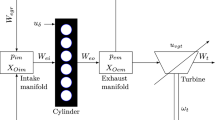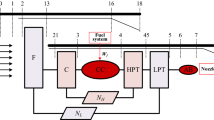Abstract
In this paper, an optimal control scheme for reducing the fluctuation of residual gas fraction (RGF) under variational operating condition is developed by combining stochastic logical system approach with statistical learning method. The method estimating RGF from measured in-cylinder pressure is introduced firstly. Then, the stochastic properties of the RGF are analyzed according to statistical data captured by conducting experiments on a test bench equipped with a L4 internal combustion engine. The influences to the probability distribution of the RGF from both control input and environment parameters are also analyzed. Based on the statistical analysis, a stochastic logical transient model is adopted for describing cyclic behavior of the RGF. Optimal control policy maps for different fixed operating conditions are calculated then. Besides, a statistical learning-based method is applied to learn the probability density function (PDF) of RGF in the real-time which is used to adjust the control MAP based on logical optimization. The whole optimal control policy map is obtained based on Gaussian process regression with consideration of statistical information of RGF. Finally, the performance of the proposed method is experimentally validated.
Similar content being viewed by others
References
Sen A K, Zheng J J, Huang Z H. Dynamics of cycle-to-cycle variations in a natural gas direct-injection spark-ignition engine. Appl Energy, 2011, 88: 2324–2334
Scappin F, Stefansson S H, Haglind F, et al. Validation of a zero-dimensional model for prediction of nox and engine performance for electronically controlled marine two-stroke diesel engines. Appl Therm Eng, 2012, 37: 344–352
Shen T. Computerized engine and control. J Soc Instrum Control Eng, 2014, 53: 655–658
Cho H, Lee K, Lee J, et al. Measurements and modeling of residual gas fraction in SI engines. SAE Tech Paper 2001–01-1910, 2001
Lujan J M, Bermudez V, Guardiola C, et al. A methodology for combustion detection in diesel engines through in-cylinder pressure derivative signal. Mech Syst Signal Process, 2010, 24: 2261–2275
Fox J W, Cheng W K, Heywood J B. A model for predicting residual gas fraction in spark-ignition engines. SAE Tech Paper 931025, 1993
Canova M, Midlam-Mohler S, Guezennec Y, et al. Mean value modeling and analysis of HCCI diesel engines with external mixture formation. J Dyn Syst Meas Control, 2009, 131: 011002
Sen A K, Litak G, Taccani R, et al. Wavelet analysis of cycle-to-cycle pressure variations in an internal combustion engine. Chaos Soliton Fract, 2008, 38: 886–893
Heywood J B. Internal Combustion Engine Fundamentals. New York: Mcgraw Hill, 1988
Cheng D Z, Qi H S, Li Z Q. Analysis and Control of Boolean Networks: a Semi-tensor Product Approach. Berlin: Springer, 2011
Cheng D Z, Qi H S. A linear representation of dynamics of boolean networks. IEEE Trans Autom Control, 2010, 55: 2251–2258
Pal R, Datta A, Dougherty E R. Robust intervention in probabilistic boolean networks. IEEE Trans Signal Process, 2008, 56: 1280–1294
Zhao Y, Li Z Q, Cheng D Z. Optimal control of logical control networks. IEEE Trans Autom Control, 2011, 56: 1766–1776
Liu Y, Li B W, Lu J Q, et al. Pinning control for the disturbance decoupling problem of Boolean networks. IEEE Trans Autom Control, 2017. doi: 10.1109/TAC.2017.2715181
Han X G, Chen Z Q, Liu Z X, et al. Calculation of siphons and minimal siphons in petri nets based on semi-tensor product of matrices. IEEE Trans Syst Man Cybern: Syst, 2017, 47: 531–536
Li H T, Wang Y Z. Output feedback stabilization control design for Boolean control networks. Automatica, 2013, 49: 3641–3645
Lu J Q, Li H T, Liu Y, et al. Survey on semi-tensor product method with its applications in logical networks and other finite-valued systems. IET Control Theory Appl, 2017, 11: 2040–2047
Wu Y, Kumar M, Shen T. A stochastic logical system approach to model and optimal control of cyclic variation of residual gas fraction in combustion engines. Appl Therm Eng, 2016, 93: 251–259
Wu Y H, Shen T L. Policy iteration approach to control residual gas fraction in IC engines under the framework of stochastic logical dynamics. IEEE Trans Control Syst Technol, 2017, 25: 1100–1107
Yang J, Shen T L, Jiao X H. Model-based stochastic optimal air-fuel ratio control with residual gas fraction of spark ignition engines. IEEE Trans Control Syst Technol, 2014, 22: 896–910
Eriksson L, Nielsen L. Modeling and Control of Engines and Drivelines. Hoboken: John Wiley and Sons, 2014
Wu Y H, Shen T L. A matrix expression of infinite horizon optimal control problem for stochastic logical dynamical systems. In: Proceedings of the 19th International Federation of Automatic Control World Congress, Cape Town, 2014. 6965–6970
Bertsekas D P. Dynamic Programming and Optimal Control. Belmont: Athena Scientific, 1995
Wu Y H, Shen T L. An algebraic expression of finite horizon optimal control algorithm for stochastic logical dynamical systems. Syst Control Lett, 2015, 82: 108–114
Knuth D E. The Art of Computer Programming. Boston: Addison-Wesley, 1998
Devore J L. Probability and Statistics for Engineering and the Sciences. Boston: Brooks/Cole, 2009
Rasmussen C E, Williams C K I. Gaussian Processes for Machine Learning. Cambridge: MIT Press, 2006
Acknowledgements
The authors gratefully acknowledge the support and generosity of Toyota Motor Corporation, without which the present study could not have been completed.
Author information
Authors and Affiliations
Corresponding author
Rights and permissions
About this article
Cite this article
Shen, X., Wu, Y. & Shen, T. Logical control scheme with real-time statistical learning for residual gas fraction in IC engines. Sci. China Inf. Sci. 61, 010203 (2018). https://doi.org/10.1007/s11432-017-9268-2
Received:
Accepted:
Published:
DOI: https://doi.org/10.1007/s11432-017-9268-2




